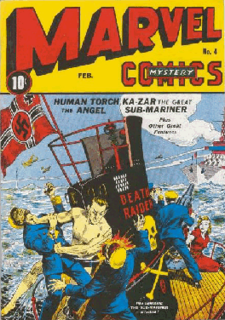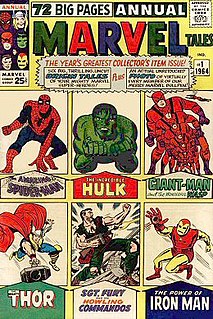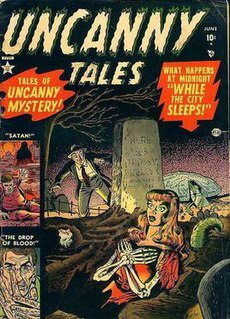Magazines
- Marvel Tales (1934 magazine), American semi-professional science fiction magazine
- Marvel Science Stories , pulp magazine titled Marvel Tales for part of its run
Marvel Tales may refer to:

Jack Kirby was an American comic book artist, writer and editor, widely regarded as one of the medium's major innovators and one of its most prolific and influential creators. He grew up in New York City and learned to draw cartoon figures by tracing characters from comic strips and editorial cartoons. He entered the nascent comics industry in the 1930s, drawing various comics features under different pen names, including Jack Curtiss, before ultimately settling on Jack Kirby. In 1940, he and writer-editor Joe Simon created the highly successful superhero character Captain America for Timely Comics, predecessor of Marvel Comics. During the 1940s, Kirby regularly teamed with Simon, creating numerous characters for that company and for National Comics Publications, later to become DC Comics.

Stephen J. Ditko was an American comics artist and writer best known as the artist and co-creator, with Stan Lee, of the Marvel Comics superheroes Spider-Man and Doctor Strange.
Entertaining Comics, more commonly known as EC Comics, was an American publisher of comic books, which specialized in horror fiction, crime fiction, satire, military fiction, dark fantasy, and science fiction from the 1940s through the mid-1950s, notably the Tales from the Crypt series. Initially, EC was owned by Maxwell Gaines and specialized in educational and child-oriented stories. After Max Gaines' death in a boating accident in 1947, his son William Gaines took over the company and began to print more mature stories, delving into genres of horror, war, fantasy, science-fiction, adventure, and others. Noted for their high quality and shock endings, these stories were also unique in their socially conscious, progressive themes that anticipated the Civil Rights Movement and dawn of 1960s counterculture. In 1954–55, censorship pressures prompted it to concentrate on the humor magazine Mad, leading to the company's greatest and most enduring success. Consequently, by 1956, the company ceased publishing all of its comic lines except Mad.

Charlton Comics was an American comic book publishing company that existed from 1945 to 1986, having begun under a different name: T.W.O. Charles Company, in 1940. It was based in Derby, Connecticut. The comic-book line was a division of Charlton Publications, which published magazines, puzzle books and, briefly, books. It had its own distribution company.

Timely Comics is the common name for the group of corporations that was the earliest comic book arm of American publisher Martin Goodman, and the entity that would evolve by the 1960s to become Marvel Comics.

Wallace Allan Wood was an American comic book writer, artist and independent publisher, widely known for his work on EC Comics's titles such as Weird Science, Weird Fantasy, and MAD Magazine from its inception in 1952 until 1964, as well as for T.H.U.N.D.E.R. Agents, and work for Warren Publishing's Creepy. He drew a few early issues of Marvel's Daredevil and established the title character's distinctive red costume. Wood created and owned the long-running characters Sally Forth and Cannon.

Marvel Mystery Comics is an American comic book series published during the 1930s–1940s period known to fans and historians as the Golden Age of Comic Books. It was the first publication of Marvel Comics' predecessor, Timely Comics, a division of Timely Publications.

Atlas Comics is the 1950s comic-book publishing label that evolved into Marvel Comics. Magazine and paperback novel publisher Martin Goodman, whose business strategy involved having a multitude of corporate entities, used Atlas as the umbrella name for his comic-book division during this time. Atlas evolved out of Goodman's 1940s comic-book division, Timely Comics, and was located on the 14th floor of the Empire State Building. This company is distinct from the 1970s comic-book company, also founded by Goodman, that is known as Atlas/Seaboard Comics.

Jack Abel was an American comic book artist best known as an inker for leading publishers DC Comics and Marvel Comics. He was DC's primary inker on the Superman titles in the late 1960s and early 1970s, and inked penciler Herb Trimpe's introduction of the popular superhero Wolverine in The Incredible Hulk #181. He sometimes used the pseudonym Gary Michaels.

Savage Tales is the title of three American comics series. Two were black-and-white comics-magazine anthologies published by Marvel Comics, and the other a color comic book anthology published by Dynamite Entertainment.
Notable events of 1949 in comics. See also List of years in comics.

Marvel Tales is the title of an American comic book series published by Marvel Comics from 1964 to 1994 and a flip magazine series published Marvel Comics by from August 2005 to February 2007. Both series primarily reprinted Spider-Man stories.
David Anthony Kraft was an American comic book writer, publisher, and critic. He was primarily known for his long-running journal of interviews and criticism, Comics Interview, as well as for work for Marvel Comics in the late 1970s and early 1980s.

Uncanny Tales is the name of two American science-fiction / horror comic-book series, published in the 1950s and the 1970s. The first volume was by Atlas Comics, the 1950s precursor of Marvel Comics, and the second volume by Marvel. It is also the title of a British comics digest.

The Savage Sword of Conan was a black-and-white magazine-format comic book series published beginning in 1974 by Curtis Magazines, an imprint of American company Marvel Comics, and then later by Marvel itself. Savage Sword of Conan starred Robert E. Howard's most famous creation, Conan the Barbarian, and has the distinction of being the longest-surviving title of the short-lived Curtis imprint.
Marvel Fireside Books were a series of full-color trade paperbacks featuring Marvel Comics stories and characters co-published by Marvel and the Simon & Schuster division Fireside Books from 1974 to 1979. The first book, 1974's Origins of Marvel Comics, was very successful, and inspired a series of annual sequels.
Monsters Unleashed is the title of an American black-and-white comics magazine published by Magazine Management and two color comic-book miniseries from Marvel Comics. The first ran from 1973 to 1975. The two miniseries ran consecutively in 2017.
Comic books have been an integral and popular part of the American rock group Kiss' merchandising since 1977, beginning with their appearance in Marvel Comics' Howard the Duck #12. Over their career of nearly four decades, Kiss has licensed their name to "more than 3,000 product(s). .. to become nearly a one-billion-dollar brand."

Horror comics are comic books, graphic novels, black-and-white comics magazines, and manga e.g. focusing on horror fiction. In the US market, horror comic books reached a peak in the late 1940s through the mid-1950s, when concern over content and the imposition of the self-censorship Comics Code Authority contributed to the demise of many titles and the toning down of others. Black-and-white horror-comics magazines, which did not fall under the Code, flourished from the mid-1960s through the early 1980s from a variety of publishers. Mainstream American color comic books experienced a horror resurgence in the 1970s, following a loosening of the Code. While the genre has had greater and lesser periods of popularity, it occupies a firm niche in comics as of the 2010s.

Dracula Lives! was an American black-and-white horror comics magazine published by Magazine Management, a corporate sibling of Marvel Comics. The series ran 13 issues and one Super Annual from 1973 to 1975, and starred the Marvel version of the literary vampire Dracula.